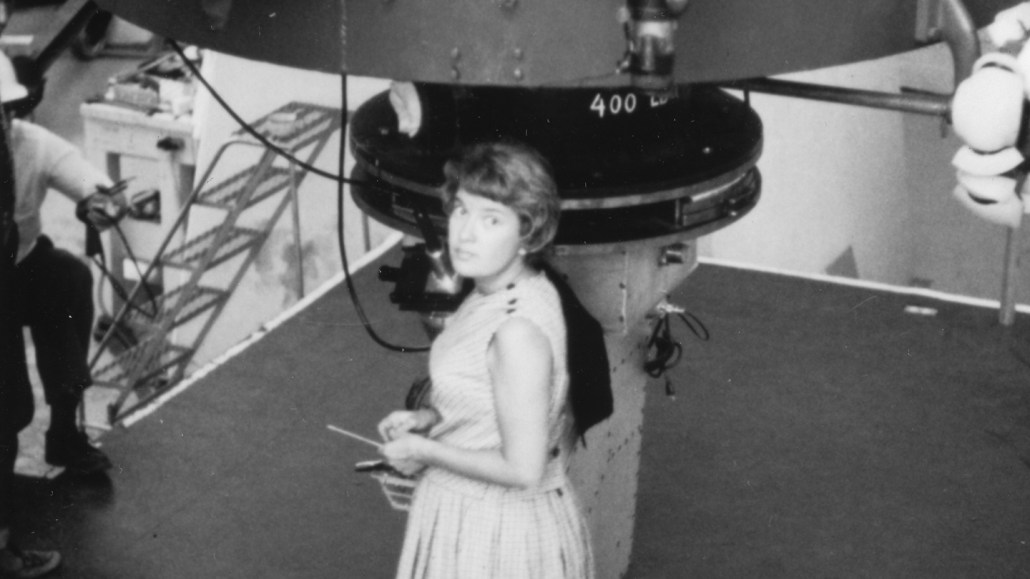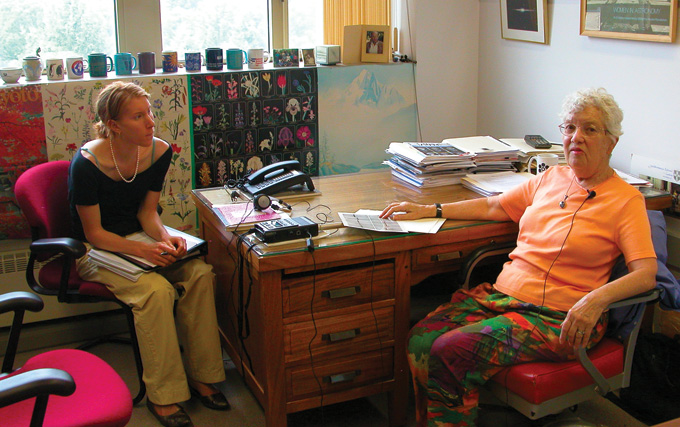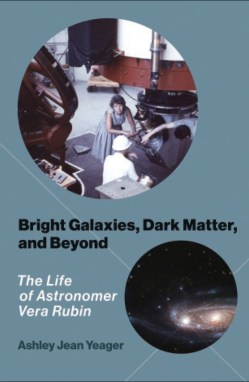
Bright Galaxies, Dark Matter, and Beyond tells how one intrepid astronomer, Vera Rubin (shown at Lowell Observatory in 1965), helped prove the existence of dark matter.
AIP EMILIO SEGRÈ VISUAL ARCHIVES, RUBIN COLLECTION
- More than 2 years ago
Bright Galaxies, Dark Matter, and Beyond
Ashley Jean Yeager
MIT Press, $24.95
Vera Rubin’s research forced cosmologists to radically reimagine the cosmos.
In the 1960s and ’70s, Rubin’s observations of stars whirling around within galaxies revealed the gravitational tug of invisible “dark matter.” Although astronomers had detected hints of this enigmatic substance for decades, Rubin’s data helped finally convince a skeptical scientific community that dark matter exists (SN: 1/10/20).
“Her work was pivotal to redefining the composition of our cosmos,” Ashley Yeager, Science News’ associate news editor, writes in her new book. Bright Galaxies, Dark Matter, and Beyond follows Rubin’s journey from stargazing child to preeminent astronomer and fierce advocate for women in science.
That journey, Yeager shows, was rife with obstacles. When Rubin was a young astronomer in the 1950s and ’60s, many observatories were closed to women, and more established scientists often brushed her off. Much of her early work was met with intense skepticism, but that only made Rubin, who died in 2016 at age 88, a more dogged data collector.
Sign up for our newsletter
We summarize the week's scientific breakthroughs every Thursday.
On graphs plotting the speeds of stars swirling around galaxies, Rubin showed that stars farther from galactic centers orbited just as fast as inner stars. That is, the galaxies’ rotation curves were flat. Such speedy outer stars must be pulled along by the gravitational grip of dark matter.
Science News staff writer Maria Temming spoke with Yeager about Rubin’s legacy and what, beyond her pioneering research, made Rubin remarkable. The following discussion has been edited for clarity and brevity.
Temming: What inspired you to tell Rubin’s story?
Yeager: It all started when I was working at the National Air and Space Museum in Washington, D.C., in 2007. I was walking around the “Explore the Universe” exhibit and noticed there weren’t many women featured. But then there was this picture of a woman with big glasses and cropped hair, and I thought, “Who is this?” It was Vera Rubin.
My supervisor was a curator of oral histories. He was working on Rubin’s, so I asked him about her. He said, “I have one more oral history interview to do with her. Would you like to come?” So I got to interview her. She was charismatic, kind and curious — not a person who was all about herself, but wanted to know about you. That stuck with me.
Temming: You spend much of the book describing evidence for dark matter besides Rubin’s research. Why?
Yeager: I wanted to make sure I didn’t portray Rubin as this lone person who discovered dark matter, because there were a lot of different moving pieces in astronomy and physics that came together in the ’70s and early ’80s for the scientific community to say, “OK, we really have to take dark matter seriously.”
Temming: What made Rubin’s work a linchpin for confirming dark matter?
Yeager: She really went after nailing down that flat rotation curve in all types of galaxies. Mainly because she did get a lot of pushback, continually, that said, “Oh, that’s just a special case in that galaxy, or that’s just for those types of galaxies.” She studied hundreds of galaxies to double-check that, yes, in fact, the rotation curves are flat. People saying, “We don’t believe you,” didn’t ever really knock her down. She just came back swinging harder.
It helped that she did the work in visible wavelengths of light. There had been a lot of radio astronomy data to suggest flat rotation curves, but because radio astronomy was very new, it was really only once you saw it with the eye that the astronomy community was convinced.
Temming: Do you have a favorite anecdote about Rubin?
Yeager: The one that comes to mind is how much she loved flowers. She told me about how on drives from Lowell Observatory to Kitt Peak National Observatory in Arizona, she and her colleague Kent Ford would always stop and buy wildflowers. The fact that picking these wildflowers stuck with her, I thought, was just representative of who she was. Her favorite moments weren’t necessarily these big discoveries she’d made, but stopping to pick some flowers and enjoy their beauty.

Temming: Did you learn anything in your research that surprised you?
Yeager: I didn’t initially grasp how many different types of projects she had. She did a lot with looking for larger-scale structure [in the universe] and looking at the Hubble constant [which describes how fast the universe is expanding] (SN: 4/21/21). She had a very diverse set of questions that she wanted to answer, well into her 70s.
Temming: I was surprised by her decision to get out of the rat-race of hunting for quasars, when that area of research heated up in the 1960s.
Yeager: She very much didn’t like to be in pressure situations where she could be wrong. She liked to go and collect so much data that no one could [dispute it]. With quasar research, it was just too fast, and she wanted to be methodical about it.
Temming: Why is Rubin’s story important to tell now?
Yeager: Unfortunately for women and minorities in science, it’s still very relevant, in that there are a lot of challenges to pursuing a career in STEM. Her story demonstrates that you have to surround yourself with people who are willing to help you and get away from the people who want to keep you down. Plus her story is also very encouraging: Your curiosity can keep you going and can fuel something way bigger than yourself.
Temming: How did she advocate for women in astronomy?
Yeager: She was very outspoken about it. At National Academy of Sciences meetings, the organizers always dreaded her standing up, because she would say, “What are we doing about women in science? We’re not doing enough.” She was constantly pushing for women to be recognized with awards. She kept tabs on the number of women who had earned Ph.D.s and who had gotten staff positions — and their salaries. She was very data-driven. She’d cull that information and use it to advocate for better representation and recognition of women in astronomy.
Temming: How would you describe Rubin to someone who hasn’t met her?
Yeager: She was one of the most persistent, gracious and nurturing people that I’ve ever met. You could strip away all that she did in astronomy and she would still be this incredible figure — the way she carried herself, the way she treated people. Just a beautiful human being.
Buy Bright Galaxies, Dark Matter, and Beyond from Bookshop.org. Science News is a Bookshop.org affiliate and will earn a commission on purchases made from links in this article.








